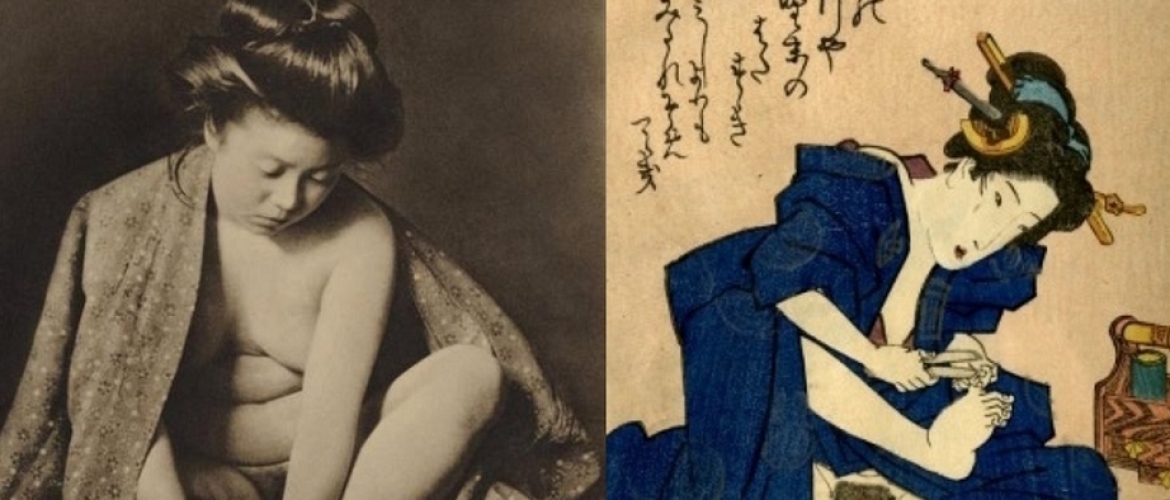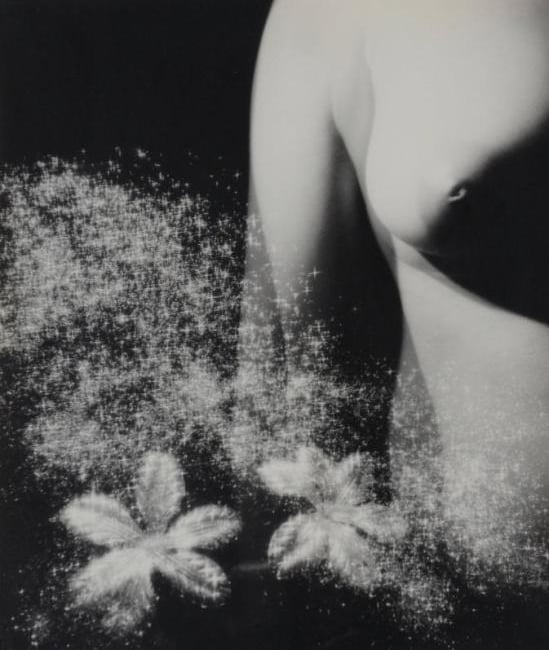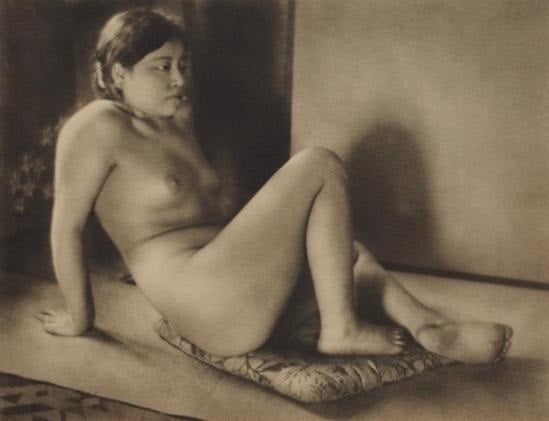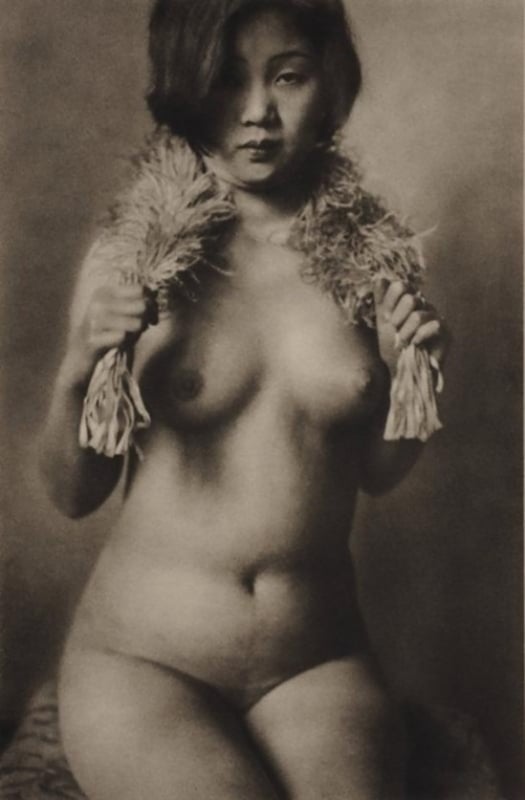
In one of our previous articles, we regarded Kansuke Yamamoto’s works as an example of productive westernization. Another Japanese photographer who successfully followed Western methods was Yasuzo Nojima (1889-1964). While the photographs of Yamamoto represent Japanese surrealism, the images by Nojima give us Japanese Vogue vibes.

Fig. 1. Model E. 1931 (lapetitemelancolie.net)

Fig. 2. Miss Chikako Hosokawa (theculturetrip.com)
Bio
Nojima was born into a family of wealthy bank manager. He began practicing photography at 17, being a student at the Keiō school. His first amateur exhibitions happened in 1909. That time he left his school studies to devote himself to photography. Several years later, in 1915, he opened the Mikasa studio in Tōkyō to exhibit the works of photographers and painters. In 1920, the studio was closed, but Nojima started painting himself. His pictures were shown in various Japanese salons. In the 1930s, together with Iwata Nakayama and Ihee Kimura, Nojima founded the Kōga review, which promoted modern photography. In 1939, the artist founded a photography club.

Fig. 3. twgreatdaily.com

Fig. 4. twgreatdaily.com
To Paint a Photograph
Nojima was an artist willing to legitimate photography as art. He displayed this intention, being a founder of different platforms connected with the new medium. His ambitions were as well manifested by the ways he treated photography in early and mature periods. At the beginning of his photographic activity, Nojima stuck to pictorialism, which was the 19th-century movement considering photography as a form of fine art. The aim was to “paint” a picture using a camera. Thus, photography was supposed to stop being something profane and vulgar and took its’ place next to fine art oeuvres by imitating them. Pictorialistic period of Nojima makes us recall abuna-e designs of beauties by Utamaro or Kunisada.

Fig. 5. Early photograph by Nojima (twgreatdaily.com)

Fig. 6. Seating Woman (blogspot.com)

Fig. 7. Early photograph by Nojima (twgreatdaily.com)

Fig. 8. Left: Woman combing her hair, 1914 (lapetiitemelancolie.files.wordpress.com); Right: Utamaro, woman combing her hair, ca. 1802-1803 (ukiyo-e.org)

Fig. 9. Seated Beauty (sakura-do.photoshelter.com)

Fig. 10. Woman, 1920 (lapetitemelancolie.net)

Fig. 11. Standing woman, 1917 (lapetitemelancolie.net)
To Photograph a Painting
In the 1920s, pictorialism was replaced by Neues Sehen ("New Vision"). This movement considered photography as self-sufficient art, which mustn't imitate painting. All avant-gardists, in general, can be described as the apologists of the New Vision. They used montage and photogram (producing images on photographic paper without a camera), unusual perspective, and multiple exposure. Nojima's works created in the 1930s demonstrate the shift in his artistic views. Photography takes its' place among other arts only by proving its' self-sufficiency.

Fig. 12. Ginreika (Loosestrife) 1940 (lapetitemelancolie.net)

Fig. 13. Ginreika (Loosestrife) 1941 (lapetitemelancolie.net)

Fig. 14. Model K, 1937 (lapetitemelancolie.net)

Fig. 15. Model K, 1938 (lapetitemelancolie.net)
Japanese Edward Weston
When Nojima became adherent to the New Vision movement, he started producing female nudes. The composition of these photos and Nojima's attitude to the process of photographing remind us of American photographer Edward Weston, whose creative method was also shaped by the New Vision. Nojima wrote the following about his work: "When I take a portrait, I move the subject towards a point where the light is adequate. Then I evaluate the quality of the light, the shadows, and forms. When I am satisfied, I shoot. I am not interested in capturing the personality of the model or in revealing her peculiarities. I shoot in tune with my perception of light and form: these are the elements that interest me." (theculturetrip.com)

Fig. 16. Nude (theculturetrip.com)

Fig. 17. Nude (lapetiitemelancolie.files.wordpress.com)

Fig. 18. Miss T, 1931 (lapetiitemelancolie.files.wordpress.com)

Fig. 19. Nude from rear, 1930 (lapetiitemelancolie.files.wordpress.com)

Fig. 20. Nude Torso, 1930, bromoil print (lapetiitemelancolie.files.wordpress.com)

Fig. 21. Femme nue de dos, 1932, gelatin silver print (lapetiitemelancolie.files.wordpress.com)

Fig. 22. Femme au miroir, 1933 (lapetiitemelancolie.files.wordpress.com)

Fig. 23. Untitled, 1933 (lapetiitemelancolie.files.wordpress.com)

Fig. 24. Breasts, 1933 gelatin silver print (lapetiitemelancolie.files.wordpress.com)

Fig. 25. Breasts, 1933 gelatin silver print (lapetiitemelancolie.files.wordpress.com)

Fig. 26. Untitled, 1921 (lapetiitemelancolie.files.wordpress.com)

Fig. 27. Untitled, 1920 (lapetiitemelancolie.files.wordpress.com)

Fig. 28. Femme nue de dos, 1921 (lapetiitemelancolie.files.wordpress.com)

Fig. 29. Femme Nue, 1921 (lapetiitemelancolie.files.wordpress.com)

Fig. 30. Femme, 1933 (lapetiitemelancolie.files.wordpress.com)

Fig. 31. twgreatdaily.com

Fig. 32. Seated Woman in Ukiyo-e manner, 1918, early pictorialistic period (lapetiitemelancolie.files.wordpress.com)

Fig. 33. Left: Untitled, 1931 (lapetiitemelancolie.files.wordpress.com); Right: Kunisada, The seven flowers of autumn, 1832

Fig. 34. Left: Untitled, 1931 (woman, probably in front of the mirror). Right: Woman looking in the mirror, Utamaro, 1790 (ukiyo-e.org)

Fig. 35. Untitled, 1931 (lapetiitemelancolie.files.wordpress.com)

Fig. 36. Untitled, 1931 (lapetiitemelancolie.files.wordpress.com)

Fig. 37. Untitled, 1931 (lapetiitemelancolie.files.wordpress.com)

Fig. 38. Untitled, 1931 (lapetiitemelancolie.files.wordpress.com)

Fig. 39. Untitled, 1931 (lapetiitemelancolie.files.wordpress.com)

Fig. 40. Untitled, 1931 (lapetiitemelancolie.files.wordpress.com)

Fig. 41. Untitled, 1931 (lapetiitemelancolie.files.wordpress.com)

Fig. 42. Untitled, 1931 (lapetiitemelancolie.files.wordpress.com)
European Manner
Another specific feature of Nojima's images is the European vibe we feel while watching them. The portraits of Japanese women are much in the spirit of the covers of popular European magazines. Nojima's models often hold a cigarette, which was a European trend and a sign of emancipation. They wear European clothes and pose to the camera in a European manner. The cultural contrast of Nojima's works, where East and West peculiarly meet each other makes them esthetically appealing and very amusing to watch.

Fig. 43. Model K, 1951 (lapetitemelancolie.net)

Fig. 44. Portrait with a Cigarette, 1930 (lapetitemelancolie.net)

Fig. 45. Young Girl, 1931 (lapetitemelancolie.net)

Fig. 46. Untitled, 1931 (lapetitemelancolie.net)

Fig. 47. Untitled, 1938 (lapetitemelancolie.net)

Fig. 48. Untitled, 1939 (lapetitemelancolie.net)

Fig. 49. Untitled, 1932 (lapetitemelancolie.net)
Click HERE for
Sources: Wikipedia.org; theculturetrip.com; lapetitemelancolie.net; twgreatdaily.com
